Multi-Year High-Voltage Power System Planning Considering Active Power Curtailment
Abstract
:1. Introduction
- What is the optimal transformation path considering conventional planning measures and APC for a planning horizon of several years?;
- When is the optimal year to invest in power line replacement measures in comparison to applying APC?;
- How can short-term expenditures from power system curtailment be compared with long-term investments in the power line replacements?
2. Method
2.1. Multi Year Power System Planning
- A strong increase of RES is expected in the area of consideration;
- Investments in power lines/transformers are necessary in this area in order to guarantee future supply;
- APC is an alternative option to the investment.
2.1.1. Decision Path Approach
2.1.2. Annuity and Discounted Cash Flow Method
2.2. Problem Formulation
2.2.1. Operational Optimization
2.2.2. Planning Optimization
3. Results—SimBench Case Study
3.1. Benchmark Data and Assumptions
3.2. Planning Scenarios
- A worst-case solution considering reinforcement under worst-case assumptions and RES reduction factors without time series as a baseline value (reference method);
- A time-series-based reinforcement-only solution without considering any curtailment;
- A time-series-based curtailment-only solution without considering any grid reinforcement measures;
- A time-series-based combined solution of reinforcement and curtailment measures as a result of the integrated optimization method proposed in this paper.
3.3. Planning Results
3.4. Sensitivity Analysis
4. Discussion
5. Conclusions
Author Contributions
Funding
Conflicts of Interest
Nomenclature
| binary variable which is 1 if a power line is replaced and 0 otherwise | |
| binary variable which is 1 if an additional power line is installed and 0 otherwise | |
| branch voltage angle difference bounds | |
| replacement cost of power line measure m in EUR km−1 | |
| installation cost of an additional line measure m in EUR km−1 | |
| cost of power generation in EUR MWh−1 | |
| interest rate | |
| branch current limit | |
| q | interest factor |
| branch apparent power limit | |
| voltage bounds | |
| A | annuity |
| B | set of branches |
| G | set of generators |
| acquisition cost | |
| N | set of buses |
| power line replacement measure set | |
| additional line measure set | |
| real power injection of generator k | |
| R | reference buses |
| load apparent power demand | |
| generator apparent power dispatch | |
| branch apparent power flow (PF) | |
| generator complex power bounds | |
| bus complex voltage |
Abbreviations
| AC | alternating current |
| APC | active power curtailment |
| CAPEX | capital expenditures |
| DCF | discounted cash flow |
| HV | high voltage |
| NPV | net present value |
| OPEX | operational expenditures |
| OPF | optimal power flow |
| PF | power flow |
| RES | renewable energy sources |
| TNEP | transmission network expansion planning |
| TOTEX | total expenditures |
References
- Bundesministerium der Justiz und Verbraucherschutz. Gesetz über die Elektrizitäts- und Gasversorgung (Energiewirtschaftsgesetz - EnWG). 2005. Available online: https://www.gesetze-im-internet.de/enwg_2005/ (accessed on 18 September 2020).
- Ude, N.G.; Yskandar, H.; Graham, R.C. A Comprehensive State-of-the-Art Survey on the Transmission Network Expansion Planning Optimization Algorithms. IEEE Access 2019, 7, 123158–123181. [Google Scholar] [CrossRef]
- Resener, M.; Haffner, S.; Pereira, L.A.; Pardalos, P.M. Optimization Techniques Applied to Planning of Electric Power Distribution Systems: A Bibliographic Survey. Energy Syst. 2018, 9, 473–509. [Google Scholar] [CrossRef]
- Mahdavi, M.; Antunez, C.S.; Ajalli, M.; Romero, R. Transmission Expansion Planning: Literature Review and Classification. IEEE Syst. J. 2019, 13, 3129–3140. [Google Scholar] [CrossRef]
- Schlabbach, J.; Rofalski, K.H. Power System Engineering: Planning, Design, and Operation of Power Systems and Equipment, 2nd ed.; John Wiley & Sons: Hoboken, NJ, USA, 2014. [Google Scholar]
- Hansen, K.; Mathiesen, B.V.; Skov, I.R. Full energy system transition towards 100% renewable energy in Germany in 2050. Renew. Sustain. Energy Rev. 2019, 102, 1–13. [Google Scholar] [CrossRef]
- Höflich, B.; Richard, P.; Völker, J.; Rehtanz, C.; Greve, M.; Gwisdorf, B.; Kays, J.; Noll, T. dena-Verteilnetzstudie Ausbau-Und Innovationsbedarf der Stromverteilnetze in Deutschland bis 2030; Deutsche Energie-Agentur: Berlin Germany, 2012. [Google Scholar]
- Buechner, J.; Katzfey, J.; Floercken, O.; Moser, A.; Schuster, H.; Dierkes, S.; van Leeuwen, T.; Verheggen, L.; Uslar, M.; van Amelsvoort, M. Moderne Verteilernetze für Deutschland (Verteilernetzstudie); Bundesministeriums für Wirtschaft und Energie (BMWi): Bonn, Germany, 2014. [Google Scholar]
- Ackermann, T.; Martensen, N.; Brown, T.; Untsch, S.; Tröster, E.; Geidel, S.; Koch, M.; Bauknecht, D.; Heinemann, C.; Ritter, D.; et al. Verteilnetzstudie Rheinland-Pfalz. In Hg. v. Ministerium für Wirtschaft, Klimaschutz, Energie und Landesplanung Rheinland-Pfalz (MWKEL); Energynautics GmbH: Langen, Germany, 2014. [Google Scholar]
- Rehtanz, C.; Moser, A.; Kays, J. Leistungsfähigkeit und Ausbaubedarf der Verteilnetze in Nordrhein-Westfalen (Gutachten); Dortmund: Aachen, Germany, 2014. [Google Scholar]
- Rehtanz, C.; Greve, M.; Häger, U.; Hagemann, Z.; Kippelt, S.; Kittl, C.; Koubert, M.L.; Pohl, O.; Rewald, F.; Wagner, C. Verteilnetzstudie für das Land Baden-Württemberg; Ministerium für Umwelt, Klima und Energiewirtschaft Baden Württemberg: Dortmund, Deutschland, 2017.
- Braun, M.; Krybus, I.; Becker, H.; Bolgaryn, R.; Dasenbrock, J.; Gauglitz, P.; Horst, D.; Pape, C.; Scheidler, A.; Ulffers, J. Verteilnetzstudie Hessen 2024–2034. 2019. Available online: https://www.energieland.hessen.de/verteilnetzstudie_hessen (accessed on 21 July 2020).
- E-Bridge Consulting GmbH. Wirtschaftlicher Vorteil der netzdienlichen Nutzung von Flexibilität in Verteilnetzen. 2019. Available online: https://www.e-bridge.de/wp-content/uploads/2019/02/20190212_Studie-E-Bridge_Vorteil_netzdienlicher-Flexibilität_final.pdf (accessed on 24 July 2020).
- Deutsche Energieagentur (Dena). Dena-Netzflexstudie Optimierter Einsatz von Speichern für Netz-und Marktanwendungen in der Stromversorgung. 2017. Available online: https://www.dena.de/themen-projekte/projekte/energiesysteme/netzflexstudie (accessed on 24 July 2020).
- Deng, X.; Lv, T. Power system planning with increasing variable renewable energy: A review of optimization models. J. Clean. Prod. 2020, 246, 118962. [Google Scholar] [CrossRef]
- VDE Verband der Elektrotechnik|FNN. FNN-Hinweis Spitzenkappung: Spitzenkappung—Ein Neuer Planerischer Freiheitsgrad: Spitzenkappung. 2017. Available online: https://www.vde.com/resource/blob/1578210/285c23868325c8e31c60d81ebb0b2967/hinweis-spitzenkappung-data.pdf (accessed on 24 July 2020).
- Liere-Netheler, I.; Schuldt, F.; von Maydell, K.; Agert, C. Simulation of Incidental Distributed Generation Curtailment to Maximize the Integration of Renewable Energy Generation in Power Systems. Energies 2020, 13, 4173. [Google Scholar] [CrossRef]
- Liere-Netheler, I.; Schuldt, F.; von Maydell, K.; Agert, C. Optimised curtailment of distributed generators for the provision of congestion management services considering discrete controllability. IET Gener. Transm. Distrib. 2020, 14, 735–744. [Google Scholar] [CrossRef]
- Meier, F.; Tobermann, C.; Braun, M. Retrospective optimal power flow for low discriminating active power curtailment. In 2019 IEEE Milan PowerTech; IEEE: Piscataway, NJ, USA, 2019. [Google Scholar] [CrossRef]
- Andrychowicz, M. Comparison of the Use of Energy Storages and Energy Curtailment as an Addition to the Allocation of Renewable Energy in the Distribution System in Order to Minimize Development Costs. Energies 2020, 13, 3746. [Google Scholar] [CrossRef]
- Müller, U.P.; Schachler, B.; Scharf, M.; Bunke, W.D.; Günther, S.; Bartels, J.; Pleßmann, G. Integrated Techno-Economic Power System Planning of Transmission and Distribution Grids. Energies 2019, 12, 2091. [Google Scholar] [CrossRef] [Green Version]
- Dalhues, S.; Zhou, Y.; Pohl, O.; Rewald, F.; Erlemeyer, F.; Schmid, D.; Zwartscholten, J.; Hagemann, Z.; Wagner, C.; Gonzalez, D.M.; et al. Towards research and practice of flexibility in distribution systems: A review. CSEE J. Power Energy Syst. 2019, 5, 285–294. [Google Scholar] [CrossRef]
- Meinecke, S.; Sarajlić, D.; Drauz, S.R.; Klettke, A.; Lauven, L.P.; Rehtanz, C.; Moser, A.; Braun, M. SimBench—A Benchmark Dataset of Electric Power Systems to Compare Innovative Solutions Based on Power Flow Analysis. Energies 2020, 13, 3290. [Google Scholar] [CrossRef]
- Scheffler, J. Verteilnetze auf dem Weg zum Flächenkraftwerk; Springer: Berlin/Heidelberg, Germany, 2016. [Google Scholar] [CrossRef]
- Schwab, A.J. Elektroenergiesysteme; Springer: Berlin/Heidelberg, Germany, 2017. [Google Scholar] [CrossRef]
- Hillier, D.; Ross, S.; Westerfield, R.; Jaffe, J.; Jordan, B. Corporate Finance, 12th ed.; McGraw Hill: New York, NY, USA, 2019. [Google Scholar]
- Wood, A.J.; Wollenberg, B.F.; Sheblé, G.B. Power Generation, Operation, and Control; John Wiley & Sons: Hoboken, NJ, USA, 2013. [Google Scholar]
- Thurner, L.; Scheidler, A.; Schäfer, F.; Menke, J.H.; Dollichon, J.; Meier, F.; Meinecke, S.; Braun, M. Pandapower—An Open-Source Python Tool for Convenient Modeling, Analysis, and Optimization of Electric Power Systems. IEEE Trans. Power Syst. 2018, 33, 6510–6521. [Google Scholar] [CrossRef] [Green Version]
- Coffrin, C.; Bent, R.; Sundar, K.; Ng, Y.; Lubin, M. PowerModels. JL: An Open-Source Framework for Exploring Power Flow Formulations. In Proceedings of the 2018 Power Systems Computation Conference (PSCC), Dublin, Ireland, 11–15 June 2018; IEEE: Piscataway, NJ, USA, 2018. [Google Scholar] [CrossRef]
- Bent, R.; Toole, G.L.; Berscheid, A. Transmission Network Expansion Planning With Complex Power Flow Models. IEEE Trans. Power Syst. 2012, 27, 904–912. [Google Scholar] [CrossRef]
- Schäfer, F.; Scheidler, A.; Braun, M. A Hybrid Optimization Method Combining Network Expansion Planning and Switching State Optimization. IEEE Open Access J. Power Energy 2020, 7, 234–242. [Google Scholar] [CrossRef]
- Fraunhofer IEE and University of Kassel. SimBench—Benchmark Data Set for Grid Analysis, Grid Planning And Grid Operation Management. Available online: https://simbench.de/en (accessed on 24 August 2020).
- Muehlenpfordt, J. Open Power System Data Time series Database. 2019. Available online: https://data.open-power-system-data.org/time_series/2019-06-05 (accessed on 24 August 2020). [CrossRef]
- Mitteldeutsche Netzgesellschaft Strom mbH. Neubau 110-kV-Hochspannungsfreileitung Abzweig Oberelsdorf Bl. 1013 Vergleichsrechnung zur Bewertung einer alternativen Verkabelung. 2017. Available online: https://lbgr.brandenburg.de/media_fast/4055/Vergleichsrechnung_Gr%C3%A4-Schw-Fiwa_40Jahre%2011_17.pdf (accessed on 28 August 2020).
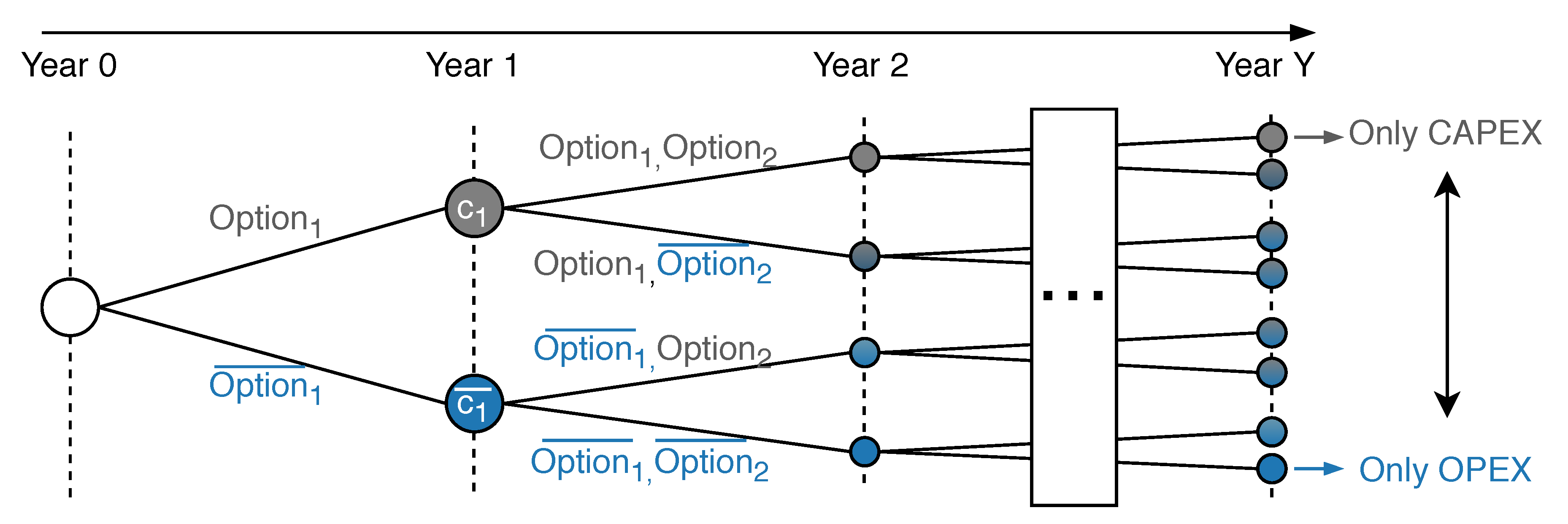


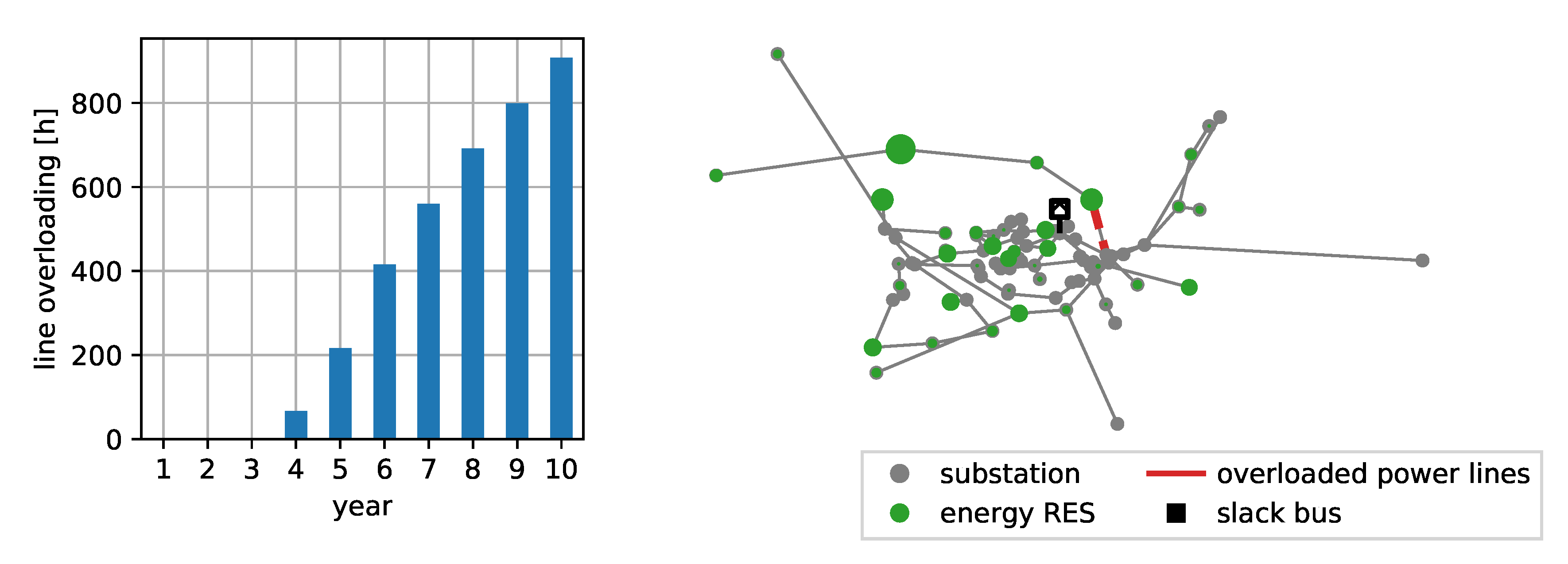
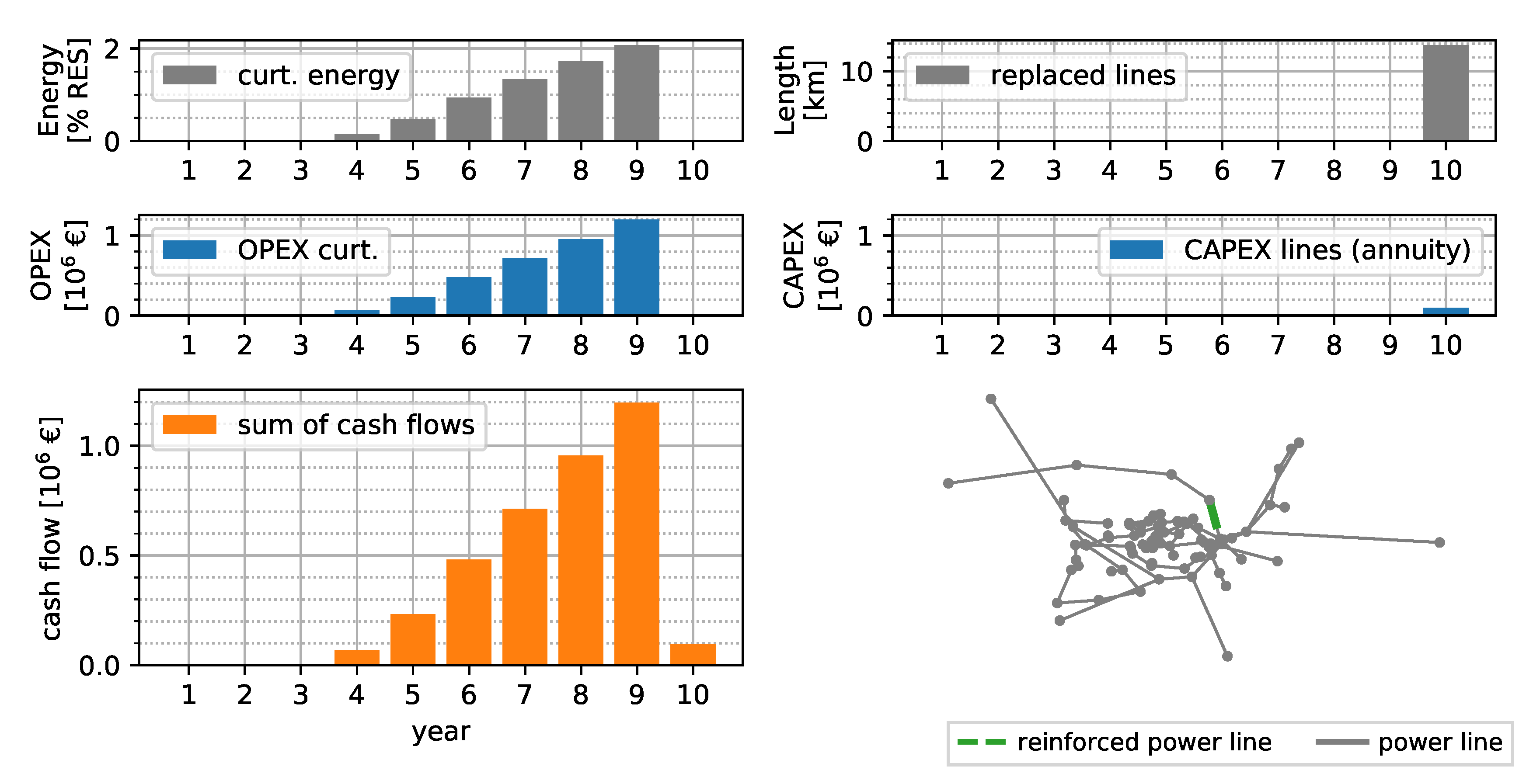

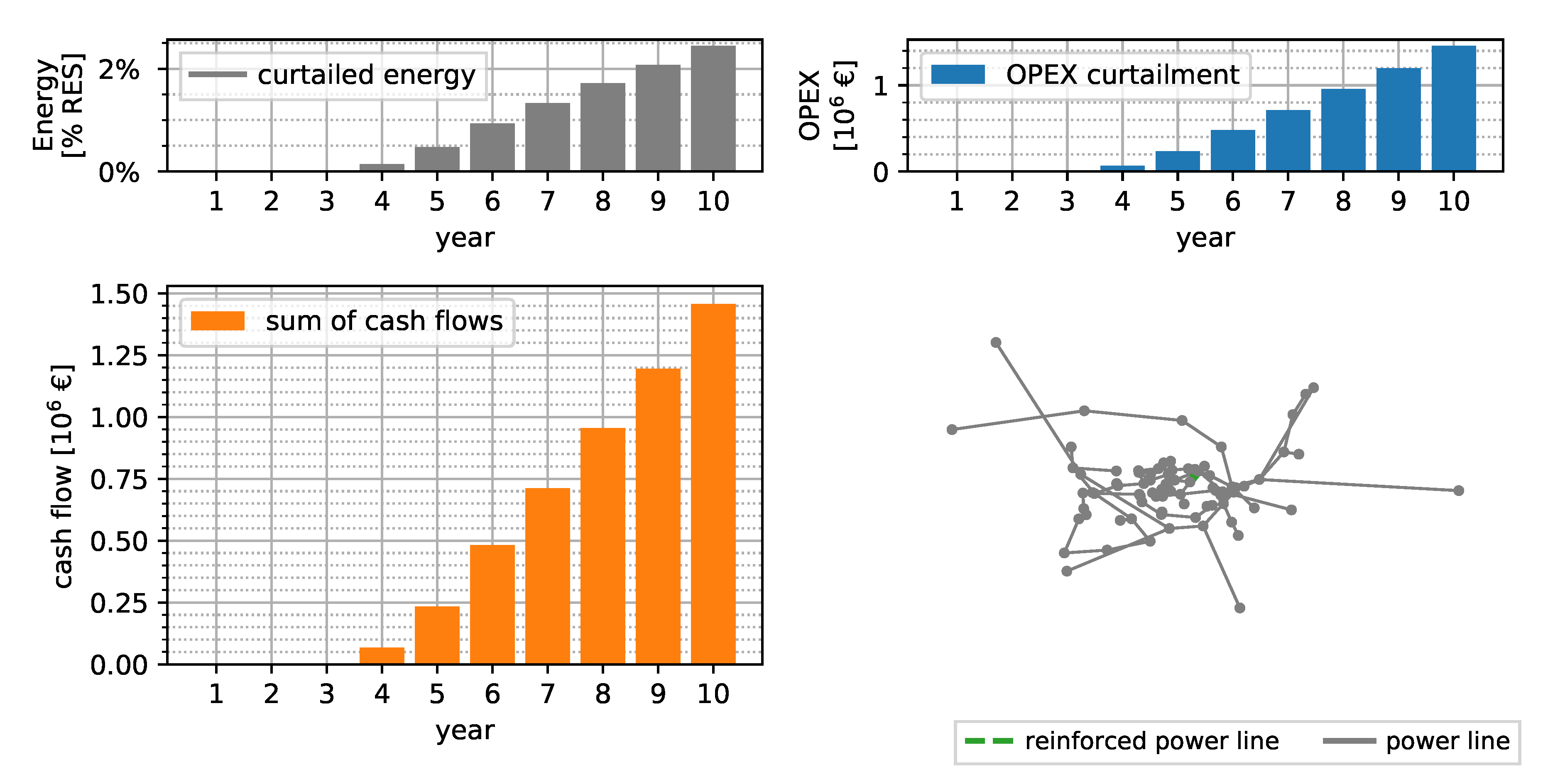


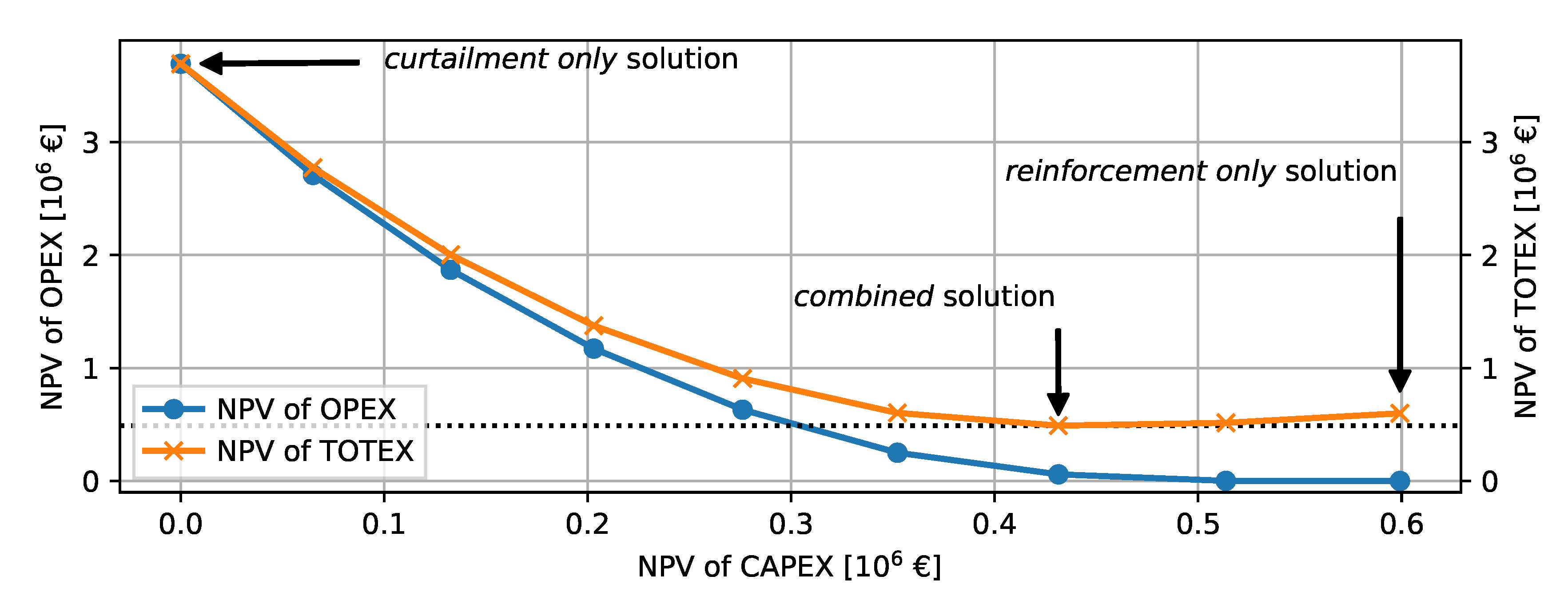

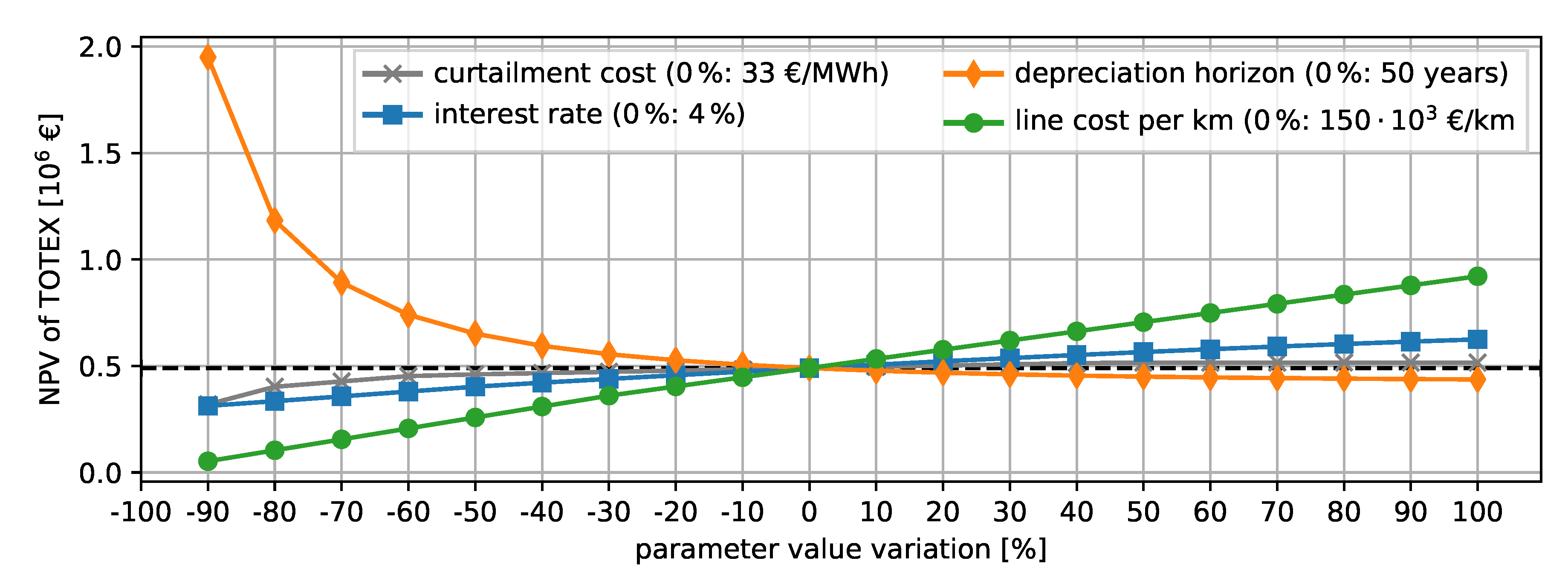
| Growth Rates | Cost Assumptions | ||||
|---|---|---|---|---|---|
| load | RES | curtailment cost | line costs | interest | depreciation horizon |
| 1% | 5% | 33 EUR MWh−1 | 150 kEUR km−1 | 4% | 50 |
© 2020 by the authors. Licensee MDPI, Basel, Switzerland. This article is an open access article distributed under the terms and conditions of the Creative Commons Attribution (CC BY) license (http://creativecommons.org/licenses/by/4.0/).
Share and Cite
Schäfer, F.; Braun, M. Multi-Year High-Voltage Power System Planning Considering Active Power Curtailment. Energies 2020, 13, 4920. https://doi.org/10.3390/en13184920
Schäfer F, Braun M. Multi-Year High-Voltage Power System Planning Considering Active Power Curtailment. Energies. 2020; 13(18):4920. https://doi.org/10.3390/en13184920
Chicago/Turabian StyleSchäfer, Florian, and Martin Braun. 2020. "Multi-Year High-Voltage Power System Planning Considering Active Power Curtailment" Energies 13, no. 18: 4920. https://doi.org/10.3390/en13184920
APA StyleSchäfer, F., & Braun, M. (2020). Multi-Year High-Voltage Power System Planning Considering Active Power Curtailment. Energies, 13(18), 4920. https://doi.org/10.3390/en13184920





